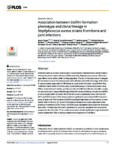Association between biofilm formation phenotype and clonal lineage in Staphylococcus aureus strains from bone and joint infections
Biofilm formation is a critical virulence factor responsible for treatment failure and chronicity in orthopaedic device-related infections (ODIs) caused by Staphylococcus aureus. Clonal lineages differ in terms of their biofilm forming capacities. The aim of this study was to investigate the correlation between the clonal complex (CC) affiliation and biofilm phenotype of 30 clinical S. aureus isolates responsible of ODI based on i) early biofilm formation using BioFilm Ring Test® and mature biofilm formation using crystal violet assays, ii) biofilm composition using DNase and proteinase K activity, and iii) prevention of biofilm formation by cloxacillin, teicoplanin and vancomycin using Antibiofilmogram® (biofilm minimal inhibitory concentration-bMIC). In terms of early biofilm formation, the CC30 strains were significantly slower than the CC5, CC15 and CC45 strains. CC45 strains produced significantly more mature biofilm than other group of strains did. The formation of biofilms was highly dependent on the presence of extracellular DNA in the CC5, CC15 and CC30 strains whereas it was mostly dependent on the presence of proteins in CC45. Finally, the CC30 group highlighted higher proportion of susceptible (bMIC < breakpoints of EUCAST guidelines) for cloxacillin, teicoplanin and vancomycin compared to the other CCs. These results demonstrate that the biofilm phenotype of clinical S. aureus isolates from ODIs is strongly related to their respective CC affiliation.



